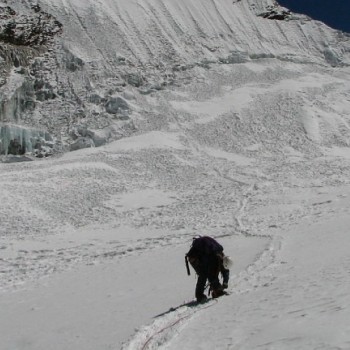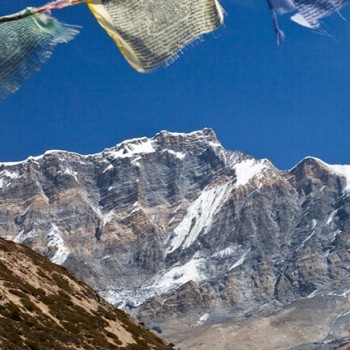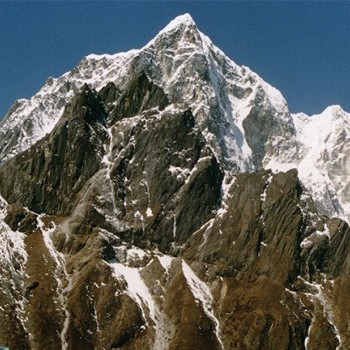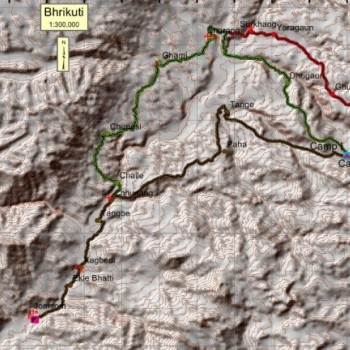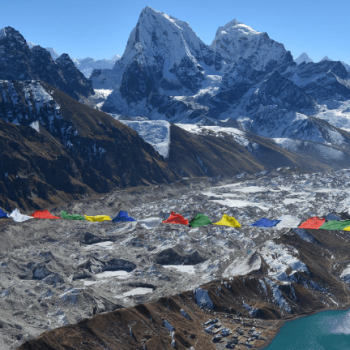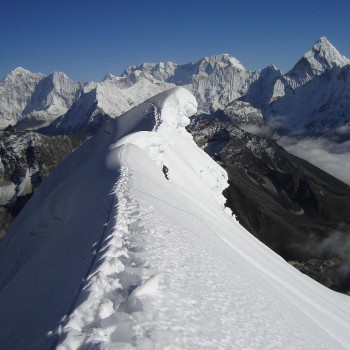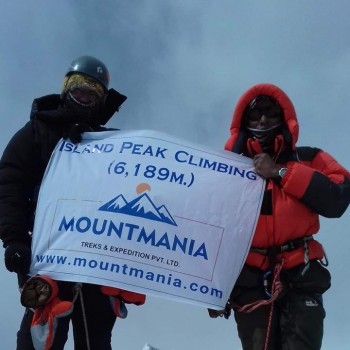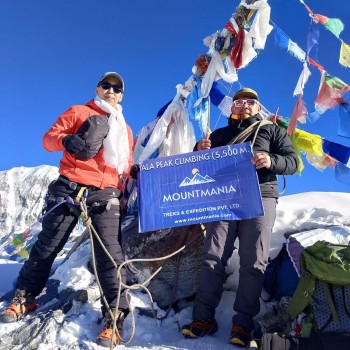Trip Details
- Destination: Nepal
- Trip Difficulty: Moderate
- Trip Style: Trekking and Climbing
- Transport: Public Vehicle & Flight
- Food: Breakfast, Lunch & Dinner
- Accommodation: Lodge & Camping
- Group Size: 2-16
- Max Elevation: 6476m
Highlights
- From Mera Peak, you can view the top of the world Mount Everest, Lhotse, Nuptse, Ama Dablam, Pumori, Kanchenjunga, Makalu, Lhotse, and Cho-Oyu
- Summit Mera Peak (6476 meters height)
- Awe-inspiring views of the entire Everest Mahalangur Himalayan range, including Mt Everest, Mt Amadablam, Lhotse, Nuptse, etc
- Passing through the stunning landscapes of Makalu Barun National Park
- Magical views of the Himalayan sunrise and sunsets
- Exploring the local settlements and their culture and heritage
- Practice and training ground for Mount Everest expedition
- Arriving at the top of the Mera Peak Summit at 6476m
- Staying at the community tea houses and lodges with incredible hospitality
- Wildlife exploration of rare and endangered species
Description
Mera Peak Climbing is popular and highest trekking peaks in Nepal. Mera Peak is situated at the height of 6470m. It has three different summits – Mera North (6470m), Mera Central (6461m) and Mera South (6065m).
On May 20, 1954, the British army officer James Owen Merion Roberts and Sen Tenzing where two climbers who successfully summited Mera Peak Central. Mera North was first summited by three Frenchmen Marcel Joly, L Honills and G Baus.
Most of the peak climbers summit Mera North due to its highest altitude among other Mera peaks. Journey to Mera Peak Climbing starts with the adventurous flight to Lukla, trekking to Mera Peak Base Camp (5400m) following the east of Lukla, and on the final day summit to Mera Peak.
Starting the trekking from Lukla, routes are covered with rhododendron flowers (in spring), silver fir, and Jennifer. After passing the Mera Peak Base Camp, there are no teahouses for foods and accommodation. Now, we have to set up a camp around high camp and to be prepared for accommodation in a tent.
While returning back from Mera Peak Summit, you will have two options to reach Kathmandu. One option is to follow the same route to Lukla. Another option is to trek through the Ampulaptsha pass and ascend towards Island Peak Base Camp which is best suited for adventurous lovers.
16 Days Mera Peak Climbing Itinerary
16 Days Mera Peak Climbing Itinerary
Hide AllDay 1: Drive to Phaplu (265km / 7-8 hrs. 2600m) and trek to Ringmo
Drive to Phaplu: Begin your journey with a scenic drive from Kathmandu to Phaplu. The drive, which takes about 7-8 hours, provides views of the rugged landscapes and the lower reaches of the Solu Khumbu.
Trek to Ringmo: From Phaplu, trek for 2-3 hours to reach Ringmo village (2,600m), a beautiful settlement in the region where you’ll spend the night.
Day 2: Trek to Khari Khola (13km / 5-6 hrs. 2194m)
Trek to Khari Khola: After breakfast, start the trek towards Khari Khola. The trail gradually ascends and passes through small villages, terraced fields, and lush forests. The journey takes around 5-6 hours.
Day 3: Trekking to Panggom (16km / 5-6 hrs. 2,846m)
Trek to Panggom: Today’s trek involves a steady ascent through dense forest and small villages. The trail offers scenic views of the surrounding mountains and takes about 5-6 hours.
Day 4: Trekking to Ningsow (14km / 4-5 hrs. 2,863m)
Trek to Ningsow: The day’s trek takes you from Panggom to Ningsow, with a duration of about 4-5 hours. You’ll pass through forests of rhododendron and pine trees, and enjoy scenic views of the surrounding valleys and peaks.
Day 5: Trekking to Chhatrwa Khola (18km / 6-7 hrs. 2,800m)
Trek to Chhatrwa Khola: Continue your journey through the Solu Khumbu region with a longer trek today, covering around 18 km in 6-7 hours. The trail passes through forests, small settlements, and some river crossings.
Day 6: Trekking to Kothe (15km / 6-7 hrs. 3,691m)
Trek to Kothe: Today’s trek takes you from Chhatrwa Khola to Kothe (3,691m), a remote settlement situated at the edge of the forested area. The trail passes through alpine meadows, and the landscape gradually opens up as you approach the higher altitudes.
Day 7: Trekking to Thaknak (10km / 3-4 hrs. 4,358m)
Trek to Thaknak: This short but steady trek takes you to Thaknak, where you will start to feel the altitude change. The landscape is more rugged, and you will start to feel the alpine environment.
Day 8: Trekking to Khare (8km / 2-3 km. 5,045m)
Trek to Khare: Today’s trek is short but steep as you ascend to Khare (5,045m). This village will be the base for your summit attempts, and it is a crucial spot for acclimatization before continuing to the higher camps.
Day 9: Khare to Mera Base Camp (7km / 2-3 hrs. 5300m)
Day 10: Mera Base Camp to High camp (6km / 4-5 hrs. 5,780m)
Trek to High Camp: The trek to Mera High Camp takes about 4-5 hours. It’s a gradual ascent along rocky and glaciated terrain. You will need to prepare for the final summit push here, so focus on acclimatization.
Day 11: Summit Mera Peak (6,461m) and back to Khare : 8-9 hours
•Summit Day: Today is the big day. The summit push starts early in the morning, around 2:00 AM. You will ascend through steep snow and ice slopes to the summit of Mera Peak (6,461m). The summit offers spectacular panoramic views of Everest, Lhotse, Makalu, and other peaks in the Khumbu region.
oReturn to Khare: After summiting, descend back to Khare via the same route. The total duration of this day is 8-9 hours.
Day 12: Reserve Day for Contingency for weather Condition
Reserve Day: This is a buffer day in case of bad weather or other delays. If everything goes smoothly, you can use this day for additional rest, exploration, or skills training in preparation for the descent.
Day 13: Khare to Kothe (14km / 4-5 hrs. 3600m)
Trek to Kothe: After the summit, begin your descent by retracing your steps back down to Kothe. This trek takes around 4-5 hours and involves a gradual descent through the alpine zone.
Day 14: Kothe to Thuli Kharka (16km / 5-6 hrs. 4100m)
Trek to Thuli Kharka: Descend further and make your way to Thuli Kharka, located at 4,100m. The trek takes 5-6 hours and passes through beautiful landscapes, crossing rivers, forests, and alpine meadows.
Day 15: Thuli Kharka to Lukla(18km / 6-7 hrs. 2860m)
Trek to Lukla: On the final day of trekking, descend to Lukla. The trail takes you through villages, forests, and terraced fields, covering a distance of 18 km in about 6-7 hours. Once in Lukla, you will be able to relax and celebrate your successful trek.
Day 16: Fly to Manthali and Drive Kathmandu from Lukla (20 minutes flight then 4 hrs drive)
Fly to Manthali: Take a 20-minute flight from Lukla to Manthali. This is often a scenic flight, offering views of the Khumbu and Solu regions.
Drive to Kathmandu: From Manthali, take a 4-hour drive to Kathmandu, where your Mera Peak climbing adventure concludes.
What to Expect
Cost Includes
- Airport pickups and drops
- Teahouse accommodation during the trekking
- Tented accommodation during the climbing
- 3 meals a day (Breakfast, Lunch, and Dinner)
- Sharing jeep Kathmandu to Sallery
- Domestic flights Lukla -Kathmandu
- English Speaking Trekking Guide (leader) and Climbing guide (leader) with Insurance, Transportation, Food, and Accommodation
- Trekking permits and Mera Peak climbing permit
- Good quality tents and kitchen utensils for camping
- Group mountaineering (climbing) equipment
- Use of sleeping bag & Duffel bag (if you don’t have your own, To be return after trip completed)
- Daily seasonal fresh fruits after dinner
- A first aid kit carried by the guide (Oximeter to measure your oxygen and pulse in high altitude)
- All government and local taxes
Cost Excludes
- International Flight Ticket and Nepalese Visa Fee
- Hotel & Meals in Kathmandu
- Extra Baggage Charges
- Extra night accommodation in Kathmandu in case of early arrival, late departure, and early return from the trek (due to any reason) than the scheduled itinerary
- Personal expenses (WiFi, Phone calls, Laundry, Bar bills, Battery Recharge, Water, Shower, and Tea / Coffee)
- Other costs not mentioned in 'Cost Includes' section
- Travel and Rescue Insurance
- Tips for Guides, Porters, and Drivers
FAQs
How long does it take to climb Mera Peak?
The ascent to the summit of Mera Peak begins gradually and is significantly influenced by prevailing weather conditions. Initially, we depart from the high camp, typically around 2 am, with an estimated duration of 5 to 6 hours to reach the summit. Subsequently, it is crucial to adopt the rest step technique when navigating steeper terrain.
Is Mera Peak harder than kilimanjaro?
Mera Peak demanded more strength and endurance training than Kilimanjaro and was undoubtedly more difficult.
What is the hiking route to Mera Peak?
Rather than taking the typical route that goes straight up the Zatra La pass, which leads to Mera Peak, we choose the path that heads south from Lukla, into the stunning Hinku Valley, and then back over the same way.
How much does it cost to climb Mera Peak?
- Mera Peak Climbing cost for solo is USD 2350 Per Person
- Mera Peak Climbing cost for (3 to 6 Pax) is USD 2000 Per Person
- Mega Peak Climbing cost for (7 to 9 Pax) is USD 1796 Per Person
Can a beginner climb Mera Peak?
Yes, Mera Peak is a trekking peak at a high altitude that is not technical. You don't require any specialized climbing abilities with ropes, gears, or the use of an ice axe to reach summit 6476M. Mera Peak is a popular spot for climbers with little to no previous mountaineering knowledge.
How difficult is Mera Peak?
The route we take to reach Mera Peak is quite difficult to trek. The trail is quite challenging and has several ups and downs.
Is Mera Peak worth it?
As you ascend Mera Peak, Mount Everest will enthrall you more. The lower paths have a wonderful blend of little rural settlements and Sherpa culture. Nepal's Everest area is a gigantic mountain range.
Which is better Island Peak or Mera Peak?
Mera Peak (6476m) is slightly higher than Island Peak (6189m). Although Mera is the highest trekking peak, the route is simple. Island Peak is more technical as it includes steeper ice climbs. Both of these mountains are suitable for beginner climbers. However, Mera can be climbed without proper climbing skills.
Is Mera Peak better than Everest Base Camp?
The route to Mera Peak is much quieter than the busier Everest Base Camp trekking route, providing a more peaceful experience. Along the way, you pass through a variety of terrains, from dusty trails to lush forests, picturesque remote villages and finally snow-capped mountain peaks.
Can you see Mount Everest from Mera Peak?
Reaching an altitude of 6,476 m, Mera peak in the Khumbu region of Nepal is known as the gateway to Everest. From the summit, you'll be treated to breathtaking views of the world's five highest mountains: Kanchenjunga, Lhotse, Makalu, Cho Oyu and no doubt Everest.
Is Mera Peak easier than island peak?
Mera Peak is technically much simpler than Island Peak, and therefore easier than Island Peak. Although technically easier, the peak is only 1,000 feet higher, experiences more strong winds than Island Peak, and can also be much colder.
How long is Mera Peak trek?
Mera Peak is the highest peak in Nepal defined as a "trekking peak". With an altitude of 6476 meter, this is a high mountain that requires little technical climbing on the usual route. Our private guided trip takes only 13 days.
Can I climb Mera Peak without guide?
No, you cannot climb Mera peak or any other mountain in Nepal without a guide. As per government rule, you can only climb a Himalayan peak or mountain in Nepal if you climb with a registered Nepal climbing company and a licensed guide.
What do I need to know about Mera Peak?
Mera Peak is classified as a trekking peak. It has three main peaks: North Mera (6,476 meters), Central Mera (6,461 meters) and South Mera (6,065 meters). The first ascent of Mera Central took place on May 20,1953.
What is the success rate of the Mera Peak summit?
Our success rate of the Mera Peak Summit is 90%.
How do I get a Mera Peak climbing permit?
You need two different permits to climb to the top: Mera climbing permit and a Makalu Barun National Park permit. You can easily get a Mera Peak climbing permit from the Nepal Mountaineering Association (NMA) and a climbing permit from the Nepal Tourism Board office in Bhirkutimandap, Kathmandu.
What to climb after Mera Peak?
Himlung Himal Expedition (7,126 meters) is one of the unique trekking campaigns in Nepal. It is located between the Annapurna Mountains and the northern Mount Manaslu (8,163 meters). This peak is an ideal choice for those looking for their next hike after Mera Peak.
How high is Mera Peak in feet?
Mera Peak is a classic Himalayan peak to climb, rising to 21,246 feet above sea level.
What do you wear to Mera Peak summit?
Packs and Bags
- Two Duffel Bags: at least one bag should be extremely durable, waterproof and large enough to fit everything you own.
- One small Duffel Bag: this bag will be useful to keep everything that is not necessary for your trip. It will be left behind in the hotel.
- Alpine Pack: it is a large size summit pack for day climb and trekking.
Clothes
- Head: A warm hat that covers your ear, face mask, and scarf
- Hands: Lightweight synthetic gloves, mittens
- Upper Body: short sleeve Merino Short, Long sleeve Merino shirt, hardshell jacket, softshell jacket, lightweight down jacket, expedition weight down jacket
- Lower Body: underwear, quick-dry shorts, softshell pants, hardshell pants, lightweight trekking pants, down or synthetic insulated pant, thermal bottoms
- Feet: thick socks, mountaineering boots, hiking shoes, sandals, liner socks,

.png)
